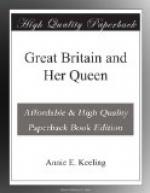Methodism in 1839 in all its branches [Footnote] reckoned more than 1,400,000 members, with 6,080 itinerant preachers and 350 missionaries; 50,000 pupils were instructed in the mission schools, and there were upwards of 70,000 communicants and at least 200,000 hearers of the gospel in Methodist mission chapels. In England alone the Wesleyan Methodists owned 3,000 chapels, and had many other preaching places; there were 3,300 Sunday schools, 341,000 scholars, and 4,000 local preachers. These figures, when, compared with those given at the end of our sketch, will furnish some idea of the numerical advance of Methodism throughout the world during the Queen’s reign.
[Footnote: “Methodism in all its branches” must be understood of all bodies bearing the name of Methodist, including the New Connexion and the Primitive Methodists. The membership of Wesleyan Methodism alone throughout the world, according to the Minutes of Conference for 1839, was 1,112,519; and the total ministry, including 335 missionaries, 4,957.]
The centenary celebrations marked the high flood-tide of spiritual prosperity for many ensuing years, for a time of great trial followed. Gladly would we forget the misunderstandings of our fathers; yet this sketch would be incomplete without reference to unhappy occurrences which caused the loss of 100,000 members, and allowance must be made for this terrible loss in estimating the progress of Wesleyan Methodism. The troubles began when certain anonymous productions, known as “Fly Sheets,” severely criticised the administration of Methodism and libellously assailed the characters of leading ministers, especially Dr. Bunting, who stood head and shoulders above all others in this Methodist war. He was chosen President when only forty-one, and on three other occasions filled the chair of the Conference. He became an authority on Methodist government and policy. Dr. Gregory says, “As an administrator, he was unapproached in sagacity, aptitude, personal influence, and indefatigability... his character was spotless.” He was a born commander. The “Liverpool Minutes,” describing the ideal Methodist preacher, are his work.
Dr. Bunting volunteered to be tried by the Conference as to the anonymous charges against him, but no one came forward with proofs to sustain them. Three ministers, Messrs. Everett, Dunn, and Griffiths, supposed to be the chief movers of this agitation, refused to be questioned on the matter, and defying the Conference, were expelled. Thereafter the agitation was kept up, and caused great disaffection in the Societies, resulting in the loss we have referred to. The seceders called themselves “Reformers”; many of them eventually joined similar bodies of seceders, forming with them the “United Methodist Free Churches.” These in 1857 reported a membership of 41,000, less than half that which was lost to Wesleyan Methodism. But now they may be congratulated on better success, the statistics for 1896 showing, at home and abroad, a total of nearly 90,000 members, with 1,622 chapels, 417 ministers, 3,448 local preachers, 1,350 Sunday schools, and 203,712 scholars. It may be noted with pleasure that the leaders of the movement outlived all hostility to the mother Church; one of them attended the Ecumenical Conference of 1881, and took the sacrament with the other delegates.




